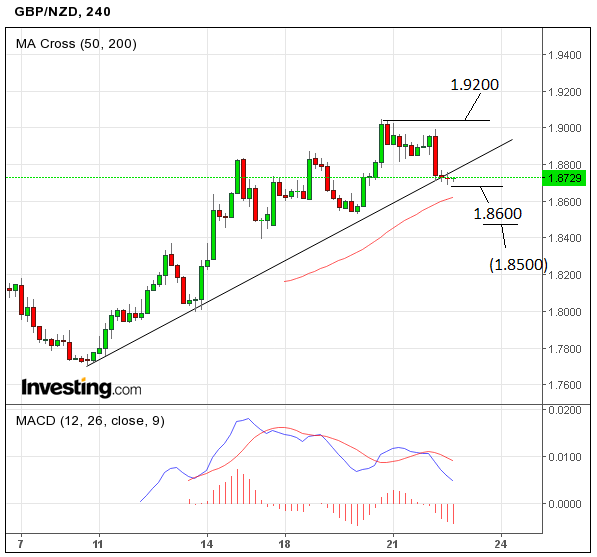New Zealand Dollar Boosted by Kiwifruit Export Surge, Trade Stats Beat Expectations
The NZ Dollar is advancing against Pound Sterling following the release of trade data which showed better-than-expected export levels with a surge in kiwifruit exports coming in for special mention.

The pound to kiwi rate rose from 1.8714 to 1.8736 in the five minutes following the release of New Zealand Trade data overnight, after the results showed a deeper-than-expected fall in the trade surplus in June.
Figures from the New Zealand office of statistics showed the country enjoyed a net surplus of 127m in June, which was below the 354m recorded in May and below the 150m forecast - nevertheless it was the sixth month in a row of surplus.
On a yearly basis the data showed the trade deficit narrow slightly to -3.13bn, from -3.62bn in the previous month.
The surplus in June was driven by a 47% rise in kiwifruit exports and a fall in imports.
The data may ratchet up pressure on the Reserve Bank of New Zealand (RBNZ) for further easing to try to devalue the currency, which would help make the country’s exports more attractive to potential buyers.
Statistics New Zealand have reported that kiwifruit exports hit a record high having achieved a 47% increase on a year-on-year basis and contributed a whopping $105M to the export basked.
"Export values of kiwifruit for the months of May and June 2016 are the two highest on record," international statistics senior manager Jason Attewell said. "Annual kiwifruit exports for the June 2016 year also set a new record – $1.7 billion – up 41 percent from the previous June year."
The rise in fruit exports eclipsed other rises in export commodities for the June 2016 year, including forestry products (up $250 million), and meat products (up $237 million).
The rise in fruit also helped to offset a fall in annual exports of milk powder, butter, and cheese (down $875 million).
Within these dairy exports there were contrasting movements; milk powder was down $1.1 billion (16 percent), with little change in the quantity exported. In contrast, the values and quantities of butter, cheese, and fresh milk and cream exported were all up in the year ended June 2016.
Kiwi Joins Commodity Bedfellows as Crude Oil Recovers
New Zealand may not be a crude producing country, but it nevertheless classed as a commodity currency owing to the importance of raw exports to the country's trade balance account.
Oil is often seen as a bellweather product for the commodity sector; hence what is good for oil is often deemed as being good for the New Zealand export basket.
It is therefore understandable that the New Zealand dollar (NZD) is trading higher against the Pound on Tuesday having noted a recovery in crude oil prices.
The week started in poor form for crude which fell by over 2% at one stage ensuring the likes of the NZD struggled. The commodity has since rebounded from three-month lows on Tuesday the 26th.
As a result, the Pound to New Zealand Dollar Exchange rate (GBP/NZD) has slipped to 1.8759 on the mid-market while your bank will be offering a rate between 1.8050 and 1.7920 on payments. Independent providers are quoting between 1.8403 and 1.8273.
Be aware that the oil-inspired nudge for NZD could be short-lived as,"ongoing fears of oversupply are encouraging hedge funds to liquidate their recent record bullish position; at the same time, we are also seeing a corresponding increase in speculative short positions," says Matt Smith at ClipperData.
Pound to New Zealand Dollar Chart Forecast: Biased to a Break Lower
The British pound could be about to end the month of July at a higher rate than where it started against the New Zealand dollar.
However, whether or not a monthly postive close occurs will depend on near-term drivers which could easily swing the exchange rate below or above 1.8794.
Looking at the pair from a technical perspective first, the GBP/NZD has fallen to an important trend-line on the 4hr chart - and may have broken through it, although it is too early to say for certain.
On balance I would be marginally biased to expecting a break lower, rather than a recovery higher.
The MACD indicator in the bottom frame has crossed over the signal line and is falling, providing a slightly bearish signal in terms of momenutm:
If the exchange rate were to move below the 1.8700 level it would probably usher in a more bearish outlook, and target 1.8600, followed possibly by 1.8500.
Longer-term, we would expect the minimum of 1.80 to remain a formidable point of support below which the pair will not cross.
Longer-term, only believe a break above the 1.9060 level would likely lead to an extension up to 1.9200.
RBNZ Still Likely to Cut
In the words of Morgan Stanley’s head of research Hans Redeker, an August rate cut is now almost a “done deal.”
Any cut to New Zealand's superior basic interest rate will likely diminish capital inflows to the country by investors who are seeking out returns in a world starved of yield.
The RBNZ’s abruptly announced ‘economic assessment’ has been seen as paving the way for more rate cuts.
The primary reason is falling inflation in Q2 due to the relatively strong New Zealand dollar which keeps the price of foreign imports pressurized.
The RBNZ seems now to be focused on trying to depreciate the currency lower, however, Redeker sees this as problematic.
“If the risk environment stays well supported and investors remain hungry for yield, it may be difficult for NZD to depreciate very much. So while we don't doubt that some depreciation is necessary, particularly if global growth and trade are weak in 2017 and China decelerates as we expect, we expect it to be mainly against USD in the medium term,” says Redeker.
While a rate cut would be deemed a negative for the currency, it must be noted that other major central banks are likely to remain in cutting mode.
The Bank of England could cut rates in August.
Therefore, any downside impact on the NZD from a RBNZ cut would likely prove limited.





